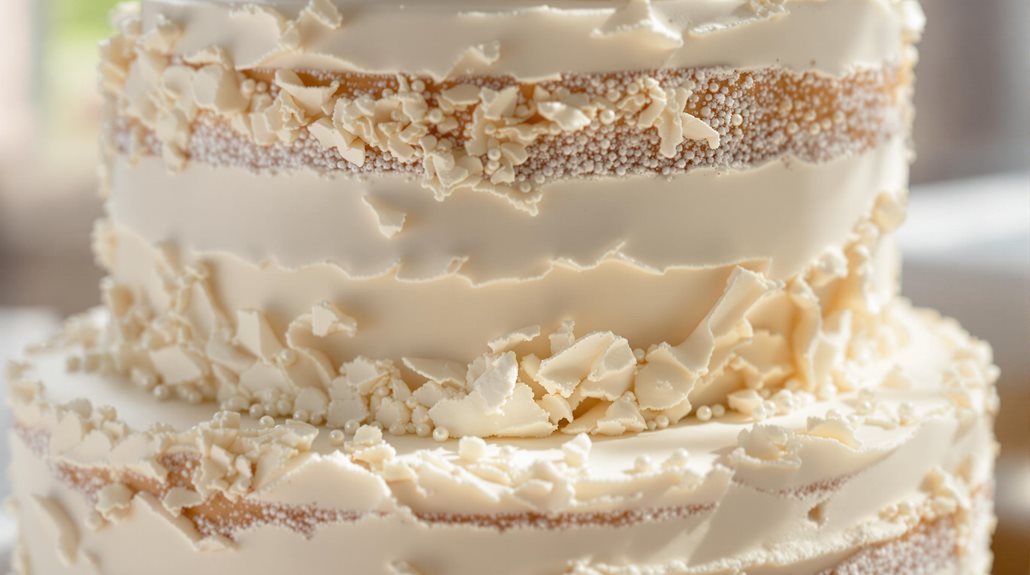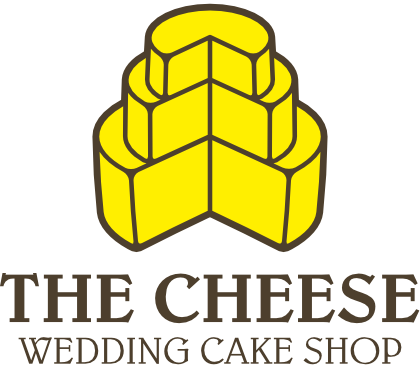
Crumbly Vs Creamy: Perfect Wedding Cake Balance
Share
To achieve the perfect wedding cake texture, you must master the delicate interplay between moisture and structure. Start with room-temperature ingredients and properly cream your butter and sugar for ideal moisture distribution.
Select cake flour for a tender crumb while ensuring your wet-to-dry ratio creates stability without sacrificing softness. Your frosting choice plays a crucial role, too - Swiss meringue buttercream offers silky smoothness, while Italian buttercream provides stability for tiered designs.
Professional bakers, with their precise measurements and proper mixing techniques, hold the key to balancing delicate crumbliness with creamy indulgence. Their expertise is your guide to the perfect wedding cake texture.
Key Takeaways
- Proper butter and sugar creaming at room temperature creates the ideal balance between crumbly texture and creamy moistness.
- Cake flour selection determines crumb structure, while wet ingredients like whole milk ensure proper creaminess.
- Italian and Swiss meringue buttercreams provide optimal silky texture without making the cake too dense or crumbly.
- Environmental humidity affects the cake's final texture, requiring careful adjustment of wet-to-dry ingredient ratios.
- Chocolate and almond cakes typically achieve better texture balance and maintain quality longer than other flavours.
Understanding Wedding Cake Textures
From delicate watercolour effects to bold geometric patterns, wedding cake textures are crucial in creating visual impact and setting the mood for your celebration. Understanding these texture options empowers you to choose a style that perfectly complements your wedding theme.
For an outdoor celebration, consider a rustic texture with its uneven buttercream application and organic appearance. This style perfectly complements natural settings and creates an earthy, inviting feel. This approach can also be applied to cheese wedding cakes, featuring layered cheese designs to add depth and variety. Naked cake designs showcase the natural layers and fillings beautifully in this setting. Royal icing provides the perfect medium for creating intricate, delicate patterns that stand out against any backdrop.
If you're drawn to romance, ruffled textures crafted from fondant or buttercream offer soft, fabric-like draping that adds sophistication to your cake's design.
Modern couples often gravitate toward geometric patterns, which incorporate clean lines and precise shapes, while embossed details can transform your cake into an intricate masterpiece through carefully pressed patterns.
For artistic flair, brushstroke techniques and watercolour effects provide unique, custom appearances. You might explore marble textures for understated luxury or concrete finishes for an urban-industrial aesthetic.
Each texture technique requires specific expertise, so partner with a baker specialising in your preferred style to achieve the perfect balance of visual interest and sophistication.
Balancing Moisture and Structure
Creating the perfect wedding cake requires mastering the delicate balance between moisture and structure. Success lies in understanding how different ingredient types interact: wet ingredients provide essential hydration, while dry components create the cake's framework.
Remember that even small variations can significantly impact your final result when working with moisture ratios. Whole milk contributes 88% water to your recipe, making it a crucial moistening agent. The temperature and timing of baking play a vital role in achieving optimal moisture retention.
Don't overlook the importance of your flour selection. Cake flour yields a more delicate crumb than all-purpose flour, so ensure they're at room temperature to achieve ideal air incorporation and moisture distribution. This attention to detail is key to achieving the perfect wedding cake texture.
Don't overlook the role of fats - they're crucial in waterproofing flour proteins and creating that sought-after velvety texture.
Environmental factors will significantly impact your cake's final texture. You'll need to account for humidity levels in your kitchen, as they can affect both the mixing and baking processes.
Store your finished cake in an airtight container to maintain perfect moisture levels, and allow proper cooling at room temperature before final assembly to ensure even moisture distribution throughout the layers.
In contrast to traditional cakes, cheese wedding cakes offer an entirely different experience. They often require special handling and refrigeration to preserve cheeses' delicate flavours and textures like artisanal cheddar.
Frosting Choices That Matter
With numerous frosting options for wedding cakes, your choice will make or break the final presentation and taste.
When selecting your frosting flavours, consider aesthetics and practicality, especially for outdoor celebrations where temperature sensitivity becomes crucial. Italian buttercream is an excellent choice for warm weather as it remains stable at room temperature.
For a classic approach, Swiss meringue buttercream offers sophistication with its silky texture and balanced sweetness. It's particularly suitable for tiered wedding cakes, as it holds up well under fondant and creates clean, sharp edges. Many couples prefer buttercream for its light, creamy texture.
When planning intricate frosting techniques, consider combining different types—perhaps for detailed piping work atop a smooth fondant surface.
Don't overlook the relationship between your cake's interior and its frosting. If you've chosen a rich chocolate cake, ganache can enhance its depth while providing a flawless finish.
For carrot or spice cakes, cream cheese frosting adds that essential tanginess. Remember, layering different frostings isn't just about aesthetics but creating a memorable taste experience.
Your frosting should be more than beautiful; it should complement your cake's flavour profile and maintain its integrity throughout your celebration.
Considering alternative wedding cake options, a cheese wedding cake can be a unique and delicious choice. It offers a variety of textures and flavours that can be carefully balanced to please diverse palates.
Layering For Stability
The foundation of a stable wedding cake lies in precise layering techniques and structural support systems. For ideal tier stability, you'll need to strategically place dowels and support rods throughout each layer. Start by measuring your tiers precisely and calculating the required number of support straws—an 8-inch tier demands four straws, while a 10-inch tier needs five. Fresh icing placement provides optimal stability during assembly. Using perforated cake boards helps achieve more seamless tier alignment during construction.
With alternative wedding cakes like cheese wedding cakes becoming increasingly popular due to their cost-effectiveness, understanding the structural aspects can also be applied creatively in designing unique and stable cheese wedding cake displays.
| Support Element | Purpose | Placement |
|---|---|---|
| Core Rod | Central stability | Centre of all tiers |
| Support Straws | Weight distribution | Circular pattern |
| Cake Boards | Tier separation | Between each layer |
| Dowel System | Structural integrity | Strategic points |
Your cake support strategy should include individual cake boards matching each tier's size. When assembling, insert dowels slightly below the surface, allowing for support caps that distribute weight evenly. Always sharpen your centre dowel using a pencil sharpener for smooth insertion through all tiers. You'll want to assemble before transport, ensuring each tier is perfectly centred and level. Remember to secure the final dowel through the serving board, locking your masterpiece into place for a flawless presentation.
Making Your Cake Last
Once your wedding cake is beautifully assembled, your next challenge is to preserve its top tier for your first anniversary celebration.
Professional cake preservation begins with proper preparation: Remove all decorations and flowers, then chill the cake to harden the icing. Pre-freeze for an hour to ensure the frosting sets completely before wrapping. An airtight container will keep your cake fresh during storage.
Transfer your cake to a plastic or foil-covered board for ideal freezing techniques, eliminating any cardboard that could affect the taste. Wrap the cake meticulously in multiple layers of plastic wrap, protecting it from freezer burn and unwanted odours. The KeepCake vacuum technology ensures maximum freshness for up to a year.
Consider investing in a specialised wedding cake freezer container for additional protection.
When your anniversary arrives, thaw the cake in your refrigerator for 24 hours, then let it reach room temperature before serving.
Be aware that certain cake varieties, like chocolate and almond, typically maintain their quality better than others. If you're concerned about freshness, you might order a replica cake from your original baker. Many couples now choose this route, though there's undeniable sentimental value in sharing your actual wedding cake on your first anniversary.
Conclusion
You've mastered the art of wedding cake engineering - congratulations! You'll never again confuse "pleasantly moist" with "disaster-in-waiting." Remember, there's a fine line between a cake that melts hearts and one that melts.
Keep your ratios tight, your layers locked, and your frosting firmly in the Goldilocks zone. And if all else fails, there's always the trusty backup plan: cupcakes.
